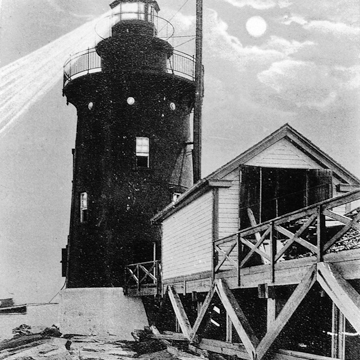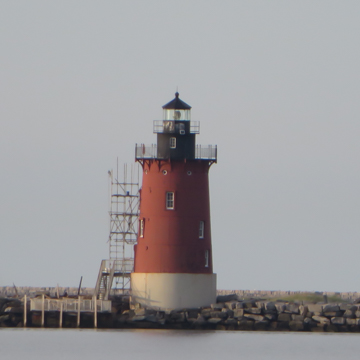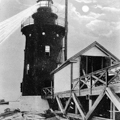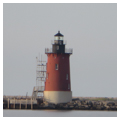Maritime interests pleaded with the federal government for a breakwater protecting vessels that were riding out a storm in Lewes Harbor. The U.S. Navy surveyed the site in 1828 in preparation for what was said to be the third really sizeable breakwater in the world (after Cherbourg, France, and Plymouth, England) and the first ever built for nonmilitary purposes. Congress appropriated funds in May of that year, and Strickland was appointed engineer, working under the Army Quartermaster General in a tempestuous relationship. Strickland was already known in Delaware for his survey of the Chesapeake and Delaware Canal (C&D) (1822). Construction of the breakwater brought huge overruns in cost and time, even after the project was scaled back.
Strickland designed two sections, the breakwater itself (2,586 feet) separated by 1,350 feet of open water from an upriver icebreaker (1,500 feet). During the 1829–1830 working seasons, stones up to two tons each were brought down from the Palisades of the Hudson River, New York. Tidal currents displaced them over the winter, so, in 1831, much larger stones were employed (up to six tons) and were positioned by four Strickland-designed derrick winches powered by hand. In 1833, 100,000 stones were delivered from quarries near Wilmington. Work was suspended in 1835 when it was discovered that Breakwater Harbor was silting up. Another campaign took place in 1836–1839, by which time the breakwater was serviceable, but stones continued to be added until 1869; 835,000 tons ultimately comprised the whole. Some blamed the gap of open water for causing harbor siltation, and it was filled in 1882–1898, as can be seen in the area of more neatly coursed stones. This failed to solve the problem, however. By that time, the total project costs over the decades had amounted to $2.6 million, and the breakwater had taken on a tragic association—the death of seventy sailors when their ships foundered here during the Blizzard of 1888.
Two lighthouses stood on the breakwater. West End was designed by Strickland in 1833 in a fascinating, hefty design of stone. Finally built in 1849 in a different form, it served until 1903 and was removed in the 1950s; some ruins of the stone foundations are visible, which once had big arches through which storm surges could pass. East End (1885–1886) is a fifty-six-foot-tall cylindrical iron tower with a brick lining, bolted to a concrete foundation. Originally painted brown, it held a Fresnel lens and Daboll trumpet foghorn. It was automated in the 1950s and recently acquired by the State of Delaware as a landmark.


























